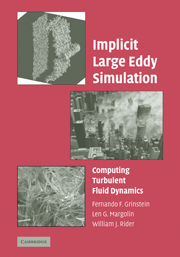Book contents
- Frontmatter
- Contents
- Preface
- List of Acronyms
- List of Contributors
- Introduction
- SECTION A MOTIVATION
- SECTION B CAPTURING PHYSICS WITH NUMERICS
- 3 Subgrid-Scale Modeling: Issues and Approaches
- 4 Numerics for ILES
- 5 Numerical Regularization: The Numerical Analysis of Implicit Subgrid Models
- 6 Approximate Deconvolution
- SECTION C VERIFICATION AND VALIDATION
- SECTION D FRONTIER FLOWS
- Index
- Plate section
6 - Approximate Deconvolution
from SECTION B - CAPTURING PHYSICS WITH NUMERICS
Published online by Cambridge University Press: 08 January 2010
- Frontmatter
- Contents
- Preface
- List of Acronyms
- List of Contributors
- Introduction
- SECTION A MOTIVATION
- SECTION B CAPTURING PHYSICS WITH NUMERICS
- 3 Subgrid-Scale Modeling: Issues and Approaches
- 4 Numerics for ILES
- 5 Numerical Regularization: The Numerical Analysis of Implicit Subgrid Models
- 6 Approximate Deconvolution
- SECTION C VERIFICATION AND VALIDATION
- SECTION D FRONTIER FLOWS
- Index
- Plate section
Summary
Introduction
In this chapter we make a connection between the filtering approach (Leonard 1974) and the averaged-equation approach (Schumann 1975) to large eddy simulation (LES). With the averaged-equation approach, the discrete system for evolving a grid-function approximation of the continuous solution is considered directly as a truncated representation of the continuous system. With the filtering approach, a continuous filtered system is considered as an approximation; the numerical error in solving this continuous system is considered to be negligibly small. The filtering approach provides an analytic framework for deriving LES equations and commonly is employed as a basis for the development of functional and structural models (Sagaut 2005) and Chapter 3 of this book. In practice, models derived on the basis of the filtering approach were plagued by the problem that the numerical error in most cases was nonnegligible. The effect of discretizing the filtered continuous equations on the subgrid-scale (SGS) force was analyzed in detail for the first time by Ghosal (1996). It was revealed that, over a large wave-number range, the truncation error of commonly employed nonspectral discretizations can be as large as the SGS stress, if not larger.
During the attempt of improving eddy-viscosity-based models, it was revealed that the correlation of predicted SGS stresses with the exact SGS stresses is much less than unity. This fact is reviewed by Meneveau and Katz (2000) on the basis of experimental data. A much larger correlation is achieved by the scale-similarity model (Bardina, Ferziger, and Reynolds 1983), which does, however, underpredict SGS dissipation.
Information
- Type
- Chapter
- Information
- Implicit Large Eddy SimulationComputing Turbulent Fluid Dynamics, pp. 222 - 242Publisher: Cambridge University PressPrint publication year: 2007
Accessibility standard: Unknown
Why this information is here
This section outlines the accessibility features of this content - including support for screen readers, full keyboard navigation and high-contrast display options. This may not be relevant for you.Accessibility Information
- 1
- Cited by
